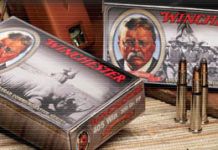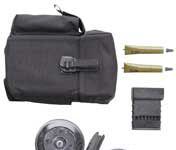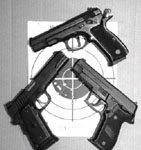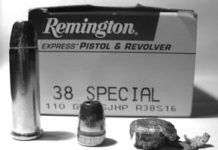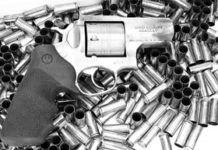Firearms Industry Statement on Passage of NICS Legislation
Industry Sales Up 5% In Second Quarter
NASR, EPA Forge Agreement
Hunters, Shooters to Top $4 Trillion in Lifetime Spending
Bureau of Alcohol, Tobacco, Firearms and Explosives Reform and Firearms Modernization Act of 2007
Winchester Wins FBI 40 S&W Ammunition Contract
Winchester’s Theodore Roosevelt Ammunition
Arizona G&FC Meeting Discusses Spent Ammo
Brownells New Product: Beta 100-Round Capacity For Enhanced Firepower
High-Capacity 9mm Pistols: We Think CZ’s 75 Is a Best Buy
A member of our staff recently returned from an intensive training session at Bill Davison's 550-acre TacPro Shooting Center located about 65 miles west of Dallas. Davison is a former Royal Marine and British Special Forces instructor widely respected as a spec-ops consultant and provider of VIP protection. Coming as a surprise to students was Davison's preference for high-capacity 9mm pistols over larger-caliber handguns, even the 1911 45. "It should be noted," Davison said, "that the whole gun is in the fight, not just one round, so when we are looking at energy levels, we should look at how much energy is in each pistol.
"For example, if the pistol has eight rounds, then it has eight times the amount of energy of a single round. The same applies to a 17-round pistol having 17 times the amount of energy of a single round. How many rounds you have in your pistol is relevant to how long you can stay in the fight.
"Based on this point of view, we decided to put together a roster of high-capacity 9mm pistols and evaluate their potential for self-defense shooting. They were the Sigarms P226R DAK, the Para Ordnance Tac Five LDA, and the CZ75B SA. The Sigarms P226R DAK offered double-action operation only. The Para Ordnance Tac Five LDA operated with a "light double action" trigger, and the CZ 75B SA was a single-action gun. Each model, however, utilized a hinged trigger.
We shot for accuracy from the 25-yard bench. We chose three test rounds. They were Speer's 124-grain Gold Dot hollowpoints, the Black Hills 115-grain JHP rounds, and 147-grain JHP subsonic ammunition from Atlanta Arms and Ammo. We evaluated the guns' rapid-fire capabilities by engaging an IPSC metric target standing offhand from 7 yards. Our drill consisted of ten separate strings of fire wherein the first two shots were aimed at the 15-cm by 28-cm center-mass A zone. The third shot of each string was aimed at the 15-cm by 15-cm "head" of the target. Naturally, we expected all shots to be on target, but we wanted to know more about shooting each gun at speed. Our goal was to maintain a rate of fire producing an elapsed time between the first and second shot of approximately 0.15 seconds. In each segment of our test, the greatest challenge we encountered was mastering three very different trigger actions. Let's see what each gun had to offer.
Light .38 Special Self-Defense Loads: We Pick Remington
The .38 Special continues to be one of the most popular revolver cartridges in production, in part because the load can be made hotter with higher-pressure +P loads, but also because it can still do a viable job of self-defense, even when loaded for standard pressures.
But one additional area of .38 Special performance is our focus here: lower-pressure, lower-recoil ammunition. Because the .38 has been popular for decades, there are many older revolvers which can't shoot higher-pressure +P loads (consult your gunsmith) safely. Also, there are many Gun Tests readers with new .38 Special or .357 Magnum revolvers who are very recoil conscious, and who might prefer a .38 round with softer recoil.
We decided to see if the lightest commercially loaded .38 Special rounds met our self-defense standards, and we added in a couple of handloads to take it down another notch or two.
Big-Bore Revolvers: For Power, Choose Rugers Super Redhawk
In this article we evaluate three guns that make no excuses for their girth. The Smith & Wesson Model 21-4 is a straightforward, large-frame revolver chambered for .44 Special only. Its .45 Colt brother, the Smith & Wesson Model 25-13, is slightly more modern, adding adjustable sights. The Ruger Super Redhawk Alaskan was fit with a longer cylinder, and together with its heavy frame, it is capable of firing .454 Casull as well as .45 Colt ammunition.
Our focus in this test was personal defense from humans and not bears, so we left the Casull rounds at home, but we did test an extra-heavy .45 Colt load from Atlanta Arms and Ammo formulated specifically for Ruger and Thompson Center firearms (
For our .44 Special rounds we chose 165-grain JHP rounds from Cor-Bon, Winchester's 200-grain Silvertip HP rounds, and 240-grain Truncated Cone Jacketed ammunition manufactured by Atlanta Arms and Ammo. Test distance was 25 yards from a sandbag rest. We fired single action only to collect hard data, but fired on steel targets double action only to evaluate rapid-fire capability. Limited to six-round capacity, we wanted to know which guns offered the right mix of power, accuracy, and speed. Here's what we learned:































